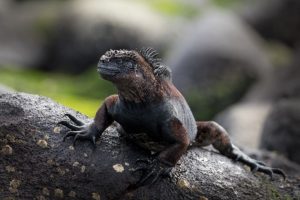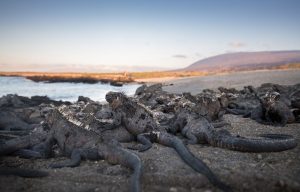
Although the first reptiles were apparently adapted to live on land, multiple lineages of reptiles have reinvaded freshwater and marine environments throughout history. Today, the adaptive success of reptiles in terrestrial environments has led to fewer than 8% of the 6000 species being primarily aquatic. Therefore, the marine iguana has arguably undergone one of the most significant evolutionary transitions among extant reptiles, being the world’s only marine lizard. However, new findings suggest that this likely incurred a reduced sprint speed and greater predation risk in a terrestrial environment, which may explain why so few extant reptiles are primarily aquatic.

Marine iguanas must overcome numerous challenges associated with feeding exclusively on subtidal marine products, however, they exhibit little departure from the physiological patterns characteristic of terrestrial iguanids. Since Charles Darwin’s initial description of the species, no studies have reappraised the morphological specialisations of marine iguana and quantified variation with terrestrial ancestors. Likewise, despite the central role performance plays in determining an individual’s fitness in a specific environment, little information exists on the locomotory ability of marine iguana in comparison to terrestrial ancestors.
This multi-institutional study examined the morphology and locomotory performance of the marine iguana in comparison to their closely related mainland ancestors, the black spiny-tailed iguana and green iguana. This comparison allowed the research team to explore the extent to which modification on the reptilian system is required for successful invasion of the marine environment. The team also investigated the magnitude of variation between divergent populations of marine iguana, following a recent taxonomic revision that recognized 11 subspecies. Read the full article here.

USC is a member of the International Galapagos Science Consortium (IGSC). IGSC, a network of collaborating institutions and scientists, is designed to provide operational support for the Galapagos Science Center and to form an alliance of international institutions including universities, research organizations, corporations, government agencies, and non-government organizations. The goal is to create a scientific network that is powered by a diversity of thought, perspectives, techniques, approaches, visions, and a data infrastructure that are leveraged through integrative science to create a collaborative global network of institutions and scholars for the innovative study of island ecosystems.

This research would not have been possible without collaboration with the Galapagos National Park, the Galapagos Science Centre, Florida Fish and Wildlife Conservation Commission and Florida Keys National Wildlife Refuges for permitting data collection and facilitating fieldwork. A special thank you to the National Geographic Society and the University of the Sunshine Coast for funding this research!
